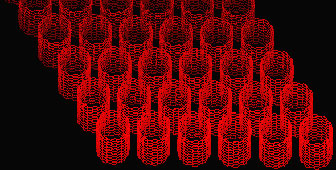The future goes bottom up

Swiss scientists and their American counterparts are discussing ways of creating new materials using nanotechnology - the manipulation of matter at the atomic scale.
“Nanostructures are the ultimate link between nature and engineered devices,” says Jürgen Brugger of the department of micro-engineering at the federal institute of technology in Lausanne.
“I think nanostructure materials will eventually have better properties for mechanics and electronics. They will make new functions possible and better products available.”
He was speaking to swissinfo during a visit by Swiss scientists to the US to discuss ways of working together in the field of nanotechology, which deals with objects measuring millionths of a millimetre.
Nanoparticles and nanopowders are used already in industries, in sun cream or in the colours of your car.
Martin Schadt, chief executive of Rolic, a Swiss company specialising in liquid crystal technologies, says Rolic has also embraced the world of nanoscience.
“Basically, we reorient molecules with electric fields and shifting them from one position to a completely different position changes the optical appearance of the molecular ensemble,” he said.
Inspired by nature
In another case, the Swiss textile technology company, Schoeller Textile, has developed a water repellent and dirt repellent finishing process, called nanosphere, which was inspired by nature.
Some plant leaves, beetle shells and insect wings stay clean because particles of dirt have difficulty sticking to their rough, structured surfaces. Thanks to new technology, Schoeller was able to emulate this process.
The resulting surface structure of their textiles limits the available contact surface for dirt particles. When it rains, any remaining particles are easily swept away.
Henry Smith, professor of electrical engineering at the Massachusetts Institute of Technology, says nature is the best example of a system functioning on the nanometre scale.
“Everything that a living system does is done at the cellular level and is done with nanostructures. If you look at what living systems do, we perform computation, we remember things, we synthesise materials, we undergo motion.
“I believe that the important impact in the future will be to expand the ability to do with artificial structures what otherwise happens in natural living systems.”
The carbon age
New carbon compounds such as the C60 molecules or nanotubes have generated considerable interest.
The hollow nanotubes – structures with walls only one atom thick, a few atoms across and hundreds of atoms long – are seen as the building blocks for stronger, lighter materials of all kinds.
At present, however, few materials are commercially available. Most are produced in small quantities in university research laboratories where yield is miniscule and cost is high.
Scientists are also excited by semiconductor nanowires. In the laboratory of Harvard professor, Charles Lieber, researchers have been pioneering ways to organise such wire structures so that ultimately they can be used for more complex and useful devices.
“Almost any high technology where you need to get information in and out requires some kind of wiring so you can take advantage of these structures not only for moving information around but for the devices themselves,” said Lieber.
Bottom up technology
Molecular manufacturing will make things by building from the bottom up, starting with the smallest possible building blocks.
Whereas top down is traditional miniaturisation, scientists are hoping to assemble larger structures from atoms and molecules.
“Bottom-up manufacturing will essentially enable any device to be made on what amounts to a laboratory bench of the future,” said Lieber.
“So instead of a million dollar fabrication line, one goes to manipulating macromolecules or nanoscale building blocks into ever increasingly complex structures but doing that in essentially solution phase processing, much like your body is assembled.”
by Vincent Landon

In compliance with the JTI standards
More: SWI swissinfo.ch certified by the Journalism Trust Initiative
You can find an overview of ongoing debates with our journalists here . Please join us!
If you want to start a conversation about a topic raised in this article or want to report factual errors, email us at english@swissinfo.ch.